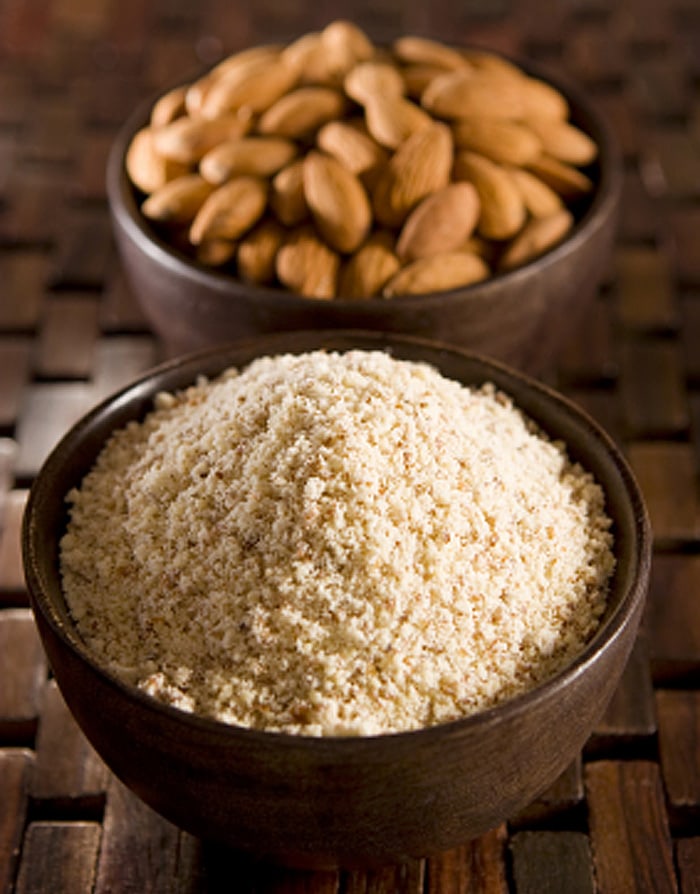
Written By: Gloria Tsang, RD
Title: Founding Registered Dietitian
Alumni: University of British Columbia
Last Updated on:

Following a gluten-free diet is a challenging exercise in itself, and when it comes to baking, it can be downright exasperating. Have you found yourself struggling with supplemental ingredients to replace wheat flour, only to end up with disappointing results? You might want to try using nut flours as an easy gluten-free substitution.
Table of Contents
Recipes for gluten-free baking using concoctions of gluten-free grains and gums are widely available, but you do not have to limit your options to grains. All nuts are gluten-free, as are nut flours. The Celiac Sprue Association provides a list of nut flours commonly used in cooking, as does Shelley Case, RD, in her book Gluten-Free Diet: A Comprehensive Resource Guide. Out of all the nut flours, almond flour is by far the most versatile. It has been used in European cooking for centuries, and its use extends beyond desserts and baking. In addition, unlike the dry and gritty texture that is common in gluten-free baked goods, foods made with almond flour are moist and have better mouthfeel. How does almond flour fare nutritionally, compared to other flours?

| Nutrient content per 1/2 cup serving | Gluten Free? | Calories (kCal) | Fat (g) | Protein (g) | Fiber (g) |
|---|---|---|---|---|---|
| All-Purpose Flour | No | 228 | 0.6 | 6.5 | 1.7 |
| Almond Flour | Yes | 320 | 28 | 12 | 6 |
| Corn Flour | Yes | 416 | 4.3 | 10.6 | 10.9 |
| Sorghum Flour | Yes | 240 | 2 | 8 | 6 |
Finally, according to Elana Amsterdam, author of The Gluten-Free Almond Flour Cookbook, almond flour is comparatively easy to work with, as there is no need to mix several grains and gums or potato flour for binding. That alone is a good enough reason to try almond flour!Almond flour is much higher in fat (most of which is the heart-healthy unsaturated kind) and protein than the other flours, which explains why you may feel fuller for longer after eating food made with almond flour.
Nut flours are different from nut meals in that a nut flour is made with blanched nuts, while a nut meal is usually made with whole nuts. You can choose to make your own nut flours at home, or you can buy them. It is, however, very important to point out that not all commercial nut flours are gluten-free. Although the nuts themselves are free of gluten, the manufacturing plant in which these nut flours are processed may not be, and may therefore contaminate the nut flours. If you are purchasing commercially prepared nut flours, you must look for a gluten-free label in order to be certain of a particular product’s gluten-free status.
In addition to almond flour, the following nut flours can also be used in cooking, but more substitutions and modifications may be required:
Almond flour’s ease of use, better taste, and nutritional merits make it a viable option for gluten-free cooking. Other nut flours can be used, but they do not seem to be as versatile. When purchasing a commercial nut flour, it is very important to check the label to ensure that it is gluten-free.
Alumni: University of British Columbia – Gloria Tsang is the author of 6 books and the founder of HealthCastle.com, the largest online nutrition network run by registered dietitians. Her work has appeared in major national publications, and she is a regularly featured nutrition expert for media outlets across the country. The Huffington Post named her one of its Top 20 Nutrition Experts on Twitter. Gloria’s articles have appeared on various media such as Reuters, NBC & ABC affiliates, The Chicago Sun-Times, Reader’s Digest Canada, iVillage and USA Today.
Cooking, Groceries, Health, Nutrition 101
baking, flour, gluten free, grocery aisle, home cooking, nuts